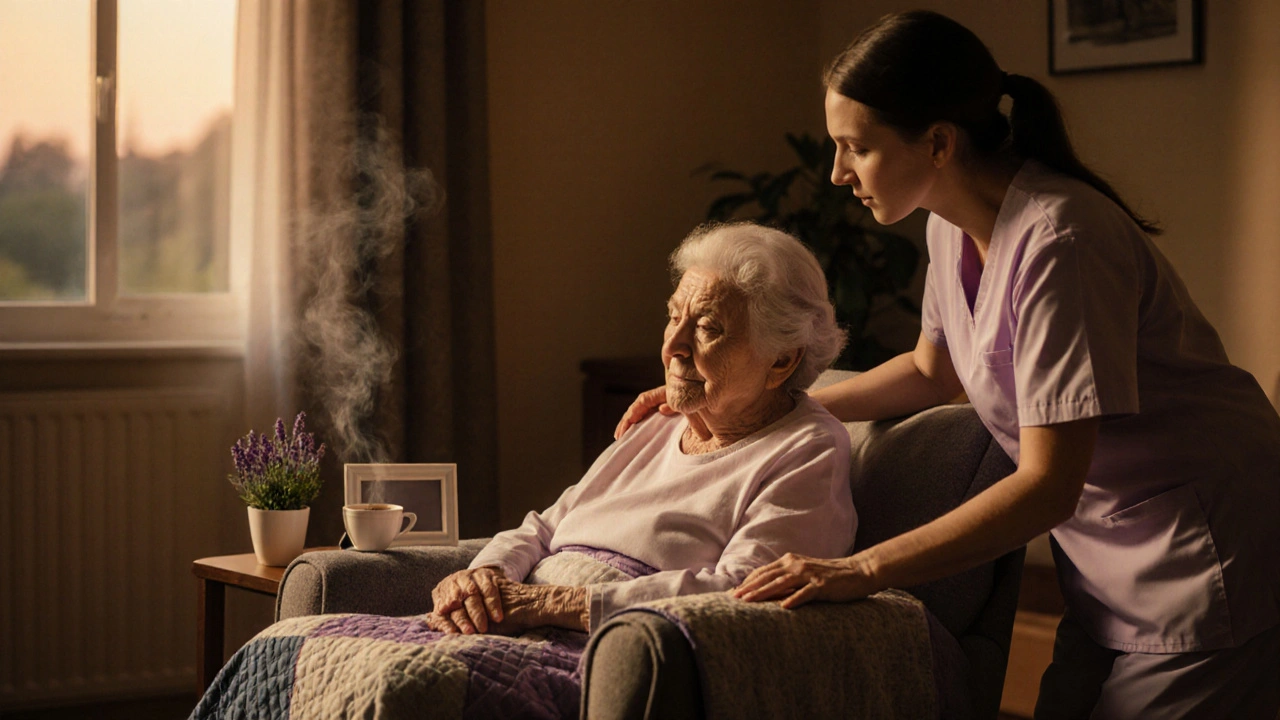Quick Takeaways
- Advanced dementia brings complex physical and emotional needs that traditional care often overlooks.
- Palliative care focuses on comfort, dignity, and quality of life, not just curative treatment.
- Key pillars include symptom control, advance care planning, psychosocial support, and caregiver relief.
- A multidisciplinary team-doctors, nurses, therapists, and spiritual advisors-coordinates care around the person’s values.
- Early integration of palliative care reduces hospital admissions and eases decision‑making for families.
When dementia reaches its later stages, families watch a loved one lose memory, communication, and basic abilities. The picture can feel bleak, and the medical system often defaults to aggressive treatments that add stress rather than relief. That’s where palliative care is a holistic approach that prioritises comfort, dignity, and personal goals for people with life‑limiting illnesses steps in. Unlike hospice, which usually begins in the final weeks of life, palliative care can start as soon as the disease progresses to a stage where symptoms become hard to manage. Below we explore how this model reshapes support for individuals living with advanced dementia and the families walking beside them.
Understanding Advanced Dementia
Advanced dementia is the severe phase of neurodegenerative decline where cognition, functional independence, and communication are profoundly impaired. At this point, the person may be unable to recognise familiar faces, swallow safely, or control continence. Physical complications such as infections, weight loss, and falls become common, while behavioural symptoms-agitation, wandering, or aggression-can surge. The disease trajectory is unpredictable; some people linger for years, others decline rapidly. Recognising these realities helps clinicians and families shift from curative expectations to comfort‑focused goals.
What Palliative Care Brings to the Table
Palliative care offers an interdisciplinary framework that addresses physical, emotional, spiritual, and social dimensions of suffering. It does not aim to hasten death, nor does it require a terminal prognosis. Instead, it asks: “What matters most to the person now?” and builds a care plan around that answer. For people with advanced dementia, this means tailoring interventions to the individual’s remaining abilities and preferences, while supporting the family’s emotional load.
Why Palliative Care Matters in Advanced Dementia
Traditional dementia care often focuses on disease‑specific tasks-memory aids, routine medical check‑ups, or medication adjustments-without a unified strategy for comfort. Palliative care fills three critical gaps:
- Symptom Management: Pain, dyspnea, constipation, and anxiety are frequent, yet they are frequently under‑treated because the person cannot verbalise discomfort. A palliative team uses regular assessments, non‑pharmacologic techniques, and judicious medication choices to alleviate suffering.
- Advance Care Planning (ACP): In the early dementia stages, the person can express wishes about future care. Palliative clinicians guide families through ACP conversations, documenting preferences for interventions like hospitalisation, artificial nutrition, or resuscitation.
- Caregiver Support: Families face grief, burnout, and decision fatigue. Palliative services provide counselling, respite resources, and education, reducing caregiver strain and improving overall wellbeing.

Core Components of Palliative Support
Each pillar aligns with a specific entity that shapes the care experience.
Symptom Management
Effective relief starts with systematic assessment. Tools such as the Pain Assessment in Advanced Dementia (PAINAD) scale help uncover hidden pain. Non‑pharmacologic measures-music therapy, gentle massage, or repositioning-are first‑line. When medications are needed, low‑dose opioids for pain or antipsychotics for severe agitation are prescribed with careful monitoring.
Advance Care Planning
During the mild‑to‑moderate stages, Advance Care Planning facilitates discussions about future medical decisions, preferred settings of care, and goals of life‑sustaining treatment. Documentation may include Do‑Not‑Resuscitate (DNR) orders, preferences for feeding tubes, or wishes to avoid intensive care. The palliative team ensures these directives travel with the patient across settings-from home to hospital to nursing facility.
Psychosocial and Spiritual Support
Even when cognition declines, emotional needs persist. A trained counsellor or chaplain can provide comfort through validated touch, familiar music, or religious rituals. Family members often need validation of their grief; sessions that normalise anticipatory loss help maintain a sense of connection.
Caregiver Relief
Caregiver refers to the family member or friend who provides daily assistance and emotional support to a person with dementia stress can lead to health problems of their own. Palliative programs offer respite care, education on safe lifting, and peer‑support groups. By addressing caregiver fatigue, the overall care environment becomes more stable.
Multidisciplinary Team Collaboration
Multidisciplinary Team includes physicians, nurses, occupational therapists, social workers, and spiritual advisors working together to deliver coordinated palliative care. Regular team meetings ensure that changes in the person’s condition trigger appropriate adjustments-whether that means adding a comfort‑focused medication or arranging a home‑based hospice‑like service.
Practical Steps for Families and Professionals
- Ask the right questions early. Involve a palliative specialist when the dementia diagnosis is confirmed, not after crises emerge.
- Document preferences. Use legally recognised ACP forms and store copies in the person’s medical record, with copies for the primary caregiver.
- Schedule routine symptom checks. A weekly review using validated scales can catch pain or distress before they spiral.
- Leverage community resources. Local dementia cafés, respite agencies, and volunteer companions can fill gaps in daily living.
- Educate the care team. Share the person’s known likes, background, and routine to personalize non‑pharmacologic interventions.
Comparing Palliative Care with Standard Dementia Care
| Aspect | Palliative Care Approach | Standard Dementia Care |
|---|---|---|
| Goal | Comfort, dignity, and alignment with personal values | Disease management and functional preservation |
| Symptom Focus | Proactive assessment, multimodal relief | Often reactive, may miss non‑verbal cues |
| Decision‑Making | Advance Care Planning central, family‑centered | Physician‑driven, limited ACP integration |
| Caregiver Support | Respite, counselling, education built‑in | Minimal, referral‑based |
| Team Structure | Multidisciplinary, regular case conferences | Primary care or single specialist focus |
Common Challenges and How to Overcome Them
Challenge 1: Misconception that palliative care means “giving up.” Many families fear that introducing palliative services signals surrender. Education that palliative care runs alongside disease‑modifying treatments dispels this myth.
Challenge 2: Access barriers. In some regions, specialist palliative teams are scarce. Tele‑health consults and training primary care physicians in basic palliative principles can bridge gaps.
Challenge 3: Communication breakdown. Dementia hampers the person’s voice, so proxy decision‑makers must rely on documented wishes. Regularly updating ACP documents and sharing them across care settings prevents conflicting instructions.

Frequently Asked Questions
When should palliative care start for someone with dementia?
Ideally early, as soon as the diagnosis is confirmed and the person can still express preferences. Early involvement helps shape a care plan that respects the individual's values before severe symptoms appear.
How is pain assessed when the person cannot speak?
Tools like PAINAD or the Abbey Pain Scale observe facial expressions, body language, vocalisations, and changes in activity. Consistent use of these scales allows clinicians to spot discomfort early.
Will palliative care replace my child's current neurologist?
No. Palliative care complements existing specialists. The neurologist continues disease‑focused treatment, while the palliative team adds comfort‑focused expertise.
What resources are available for caregiver respite?
Local council adult‑day services, charitable respite homes, and in‑home respite agencies. Many palliative programmes have partnerships that can arrange short‑term relief at low or no cost.
Can palliative medication cause sedation that worsens cognition?
Sedation is a known risk, but palliative clinicians titrate doses carefully, aiming for the lowest effective amount. The goal is comfort, not clouded awareness, and adjustments are made based on ongoing assessments.
Integrating palliative care into the journey of advanced dementia transforms a bleak trajectory into one where comfort, respect, and family cohesion take centre stage. By focusing on symptom relief, clear planning, and caregiver wellbeing, the model offers a humane alternative that aligns medical action with what truly matters.

Zach Westfall
September 28, 2025 AT 11:15The silence of unacknowledged pain in advanced dementia is a tragedy that can be turned into a gentle chorus of relief when palliative care steps in! It brings comfort where previously there was only confusion it offers a dignified pathway for families struggling with endless decisions. The focus on symptom control, rather than aggressive interventions, changes the whole narrative for the better.
Pranesh Kuppusamy
September 28, 2025 AT 22:22One must consider the hidden mechanisms that drive our healthcare institutions to prioritize curative measures even when they border on futility. In a system where profit and policy intersect, palliative care is often relegated to a secondary status, despite its proven efficacy. By integrating it early, we expose the subtle agenda that keeps families in a perpetual state of crisis management.
Nicola Gilmour
September 29, 2025 AT 09:28Honestly, this stuff can make a huge difference for families feeling lost. Remember, every small comfort you provide adds up to a better quality of life for your loved one. Keep leaning on the team and don’t forget to take a breath yourself.
Darci Gonzalez
September 29, 2025 AT 19:12Love the point about early integration – it really eases the decision‑making load for caregivers. 🌟 It’s amazing how a simple conversation about preferences can prevent a hospital trip later on. Keep the optimism flowing!
Marcus Edström
September 30, 2025 AT 03:32Exactly, those proactive talks are key. When the team aligns on goals, we avoid unnecessary interventions and preserve the person’s dignity. It’s a collaborative win for everyone involved.
Mara Mara
September 30, 2025 AT 14:05Indeed, the multidisciplinary approach-physicians, nurses, therapists, spiritual advisors-creates a safety net that catches the nuances most single‑provider models miss. By documenting preferences meticulously, we ensure continuity across settings, preventing conflicting orders, reducing readmissions, and ultimately honoring the individual’s values, which is precisely what compassionate care should look like.
Jarrod Benson
October 1, 2025 AT 00:05Let me tell you, when you start looking at the whole picture of palliative care, it’s like opening a door to a room full of possibilities. First, you get that sweet relief from pain that’s been hiding in plain sight, then you have the chance to talk honestly about what matters most-whether it’s a favorite song or a simple hug from a grandchild. The team’s ability to swing between medical expertise and gentle conversation makes the whole journey feel less like a battle and more like a shared adventure, especially when you see the caregiver’s shoulders relax a bit after a tough day. And the best part? It’s not just for the last weeks; it can start right when the dementia diagnosis becomes more than a label and actually changes daily life. So, if you’ve been stuck in the cycle of “what’s next?” consider letting palliative care be the map that guides you through the unknown with a steady hand and a compassionate heart.
Liz .
October 1, 2025 AT 09:32Totally agree with the long‑haul benefits-getting that early support can really change the vibe at home.
It’s all about keeping things smooth and humane for everyone.
tom tatomi
October 1, 2025 AT 18:25Sure, palliative care is just a fancy label for giving up.
Tom Haymes
October 2, 2025 AT 02:45Reflecting on the philosophical side, palliative care invites us to contemplate the essence of a life well‑lived, even amidst cognitive decline. By honoring personal values, it transforms medical routine into a meaningful narrative that respects both the patient and the caregiver.
Corey McGhie
October 2, 2025 AT 10:32Oh, because nothing says 'compassion' like a mountain of paperwork, right? Yet, the truth is that this very paperwork-care plans, advance directives, symptom logs-creates a safety net that catches the smallest hints of discomfort before they become crises. The multidisciplinary team, with its doctors, nurses, therapists, social workers, and chaplains, acts like an orchestra, each instrument playing its part to create harmony rather than dissonance. When a resident shows signs of agitation, the team doesn’t just reach for a medication; they consider music therapy, gentle massage, familiar scents, and even the lighting in the room. These non‑pharmacologic interventions are often the first line of defense, preserving cognition and dignity. And let’s not overlook the role of regular assessments-tools like PAINAD or the Abbey Scale turn silent suffering into observable data. This data-driven approach ensures that pain isn’t brushed aside because the patient can’t verbalize it. Moreover, the early integration of palliative care reduces unnecessary hospital admissions, which, besides being costly, can be disorienting for someone with advanced dementia. By staying home, surrounded by familiar faces and routines, the person experiences less stress and more comfort. Caregiver support, often the unsung hero of this model, includes respite services, counseling, and peer‑support groups, preventing burnout and allowing families to stay present. It’s a holistic framework that respects the person’s story, not just their diagnosis. While critics might argue that palliative care is a “soft” approach, the evidence shows it improves quality‑adjusted life years and satisfaction for both patients and families. So, when you see a team that meets weekly to adjust goals, you’re witnessing a dynamic, responsive system that adapts to the evolving needs of the individual. In short, this isn’t about giving up; it’s about giving the right kind of care at the right time, with compassion backed by evidence and collaboration.
Ajayi samson
October 2, 2025 AT 17:45The data speaks for itself-palliative care reduces readmissions, improves symptom control, and eases caregiver strain. Yet, many institutions cling to outdated models because change threatens existing revenue streams. It’s time to let the numbers drive policy, not the inertia of tradition.
Lief Larson
October 3, 2025 AT 00:25From a cultural perspective, the way we talk about end‑of‑life care varies worldwide, but the core need for dignity is universal. Embracing palliative principles bridges those gaps and offers a shared language of compassion.